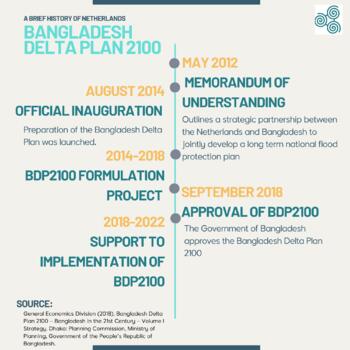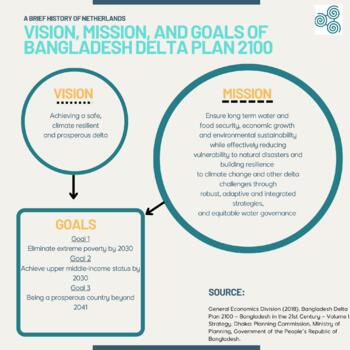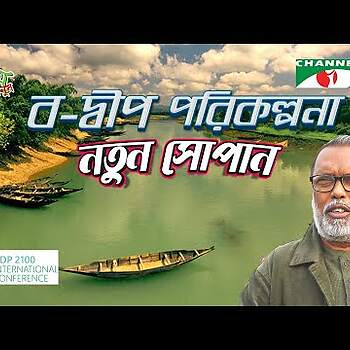Bangladesh Delta Plan 2100
Bangladesh is one of the most vulnerable countries in the world if one looks at the risks related to natural hazards and climate change. As a delta country, Bangladesh is vulnerable to expected sea-level rise. This and other climate change factors could result in increased waterlogging, security risks in terms of, floods, health, and the endangerment of the livelihood of vulnerable populations. Sectors that are vulnerable to climate change include agriculture, forestry, and ecosystems. Among other things, this could potentially result in economic losses, through loss of GDP. As a response to this, the Government of Bangladesh (GoB) decided to formulate a long-term Bangladesh Delta Plan 2100 (BDP2100), to deal with the long-term challenges that can be linked to climate change and natural hazards. Jaap de Heer in this chapter for the second version of the book ‘Moving Coastlines’ edited by Koen de Wilde (to be published soon), summarizes it as: “The BDP2100 seeks to integrate the short-to-medium-term aspirations of Bangladesh to achieve upper-middle-income status and eliminate extreme poverty by FY2031 with the longer-term challenge of sustainable management of water, ecology, environment and land resources in the context of their interaction with natural disasters and climate change”.
Timeline of the formulation of the Bangladesh Delta Plan
An important moment in the first phase of the Bangladesh Delta Plan took place in May 2012, when the Memorandum of Understanding (MoU) was signed by Planning Minister AK Khandker of Bangladesh and former Minister of International Cooperation Ben Knapen of the Netherlands. It was signed in Dhaka and it outlines a strategic partnership with the Dutch government. It includes a holistic approach, encompassing different sectors including agriculture, fisheries, industry, forestation, water management, and sanitation. The basis of the collaboration between the two countries is the Dutch experience with the Dutch Delta Plan and Program. With this MoU, it was decided that the Bangladesh Delta Plan would be developed jointly by the Netherlands and Bangladesh.
On 27 August 2014, the Bangladesh Delta Plan 2100 was officially inaugurated and the preparation of BDP 2100 was launched. It was then said by the Dutch Ambassador to Bangladesh, Gerben de Jong that the Netherlands as a delta country faces similar challenges as Bangladesh and therefore expressed excitement to start collaborating by sharing knowledge on delta management issues.
The BDP2100 Formulation Project ran from 2014 to 2018, which was followed in 2018 by the Support to Implementation of BDP2100, which will run until 2022. The Ministry of Planning, under the General Economics Division (GED) of the Planning Commission, will host both the BDP2100 and SIBDP. Thereby on 4 September 2018, the Government of Bangladesh approved the Bangladesh Delta Plan 2100.
The Adaptive Delta Management approach
For the formulation and implementation of the Bangladesh Delta Plan, the Adaptive Delta Management approach is applied. This is a long-term and holistic strategic planning approach. Jaap de Heer explains it as: managing uncertainty and risks strategically according to a long-term perspective, being prepared to some extent to immediate threats, able to adapt as and when required and when better solutions are available. It consists of ten principles. These are:
- Holistic delta analysis of issues, challenges, knowledge gaps, with awareness of need for multi-sectoral planning
- Accept uncertainty, focus on main external trends/drivers, uncertainties and impacts
- Significance of future conditions: consider scenarios as narrative of possible futures
- Short term action/ investments need to be flexible, adaptively connected with long term visions and goals, anticipating possible future changes
- Elaborate alternative adaptation pathways check for tipping points to act upon
- Institutional framework is key: institutionalization and mainstreaming of ADM-outcomes, coordination, implementation programming, monitoring and evaluation
- Decision support on strategies, investments and updating requires knowledge management and adequate data/information system
- Synergy with stakeholders, connecting with other public and private investment ambitions
- Investment planning is needed, requires an early indication of funding commitment
- Avoid over- and under investment by adaptive programming and adaptive design
In the case of BDP2100, five phases of applying ADM can be distinguished. In very brief terms, these steps are:
- The identification of characteristics, problems, and challenges.
- Definition of vision, mission, and goals, and exploration of possible options to address gaps and challenges.
- The integration of the adaptation options into management strategies.
- A process of approval including consultation, reflection and improvements of strategies and the overall plan.
- Implementation is prepared.
More about the Adaptive Delta Management approach and how the building blocks are applied in the case of the Bangladesh Delta Plan can be found in chapter 12 of the second edition of “Moving Coastlines: Emergence and Use of Land in the Ganges-Brahmaputra-Meghna Estuary”.
Visions and missions
The basis of the BDP2100 formulation were so-called baseline studies, which relate to the holistic approach to water safety and security, food security and economic growth. These baseline studies again relate to the formulation of a long-term Delta Vision and Mission, and Goals.
The long-term BDP2100 Vision is achieving a safe, climate-resilient and prosperous delta.
The BDP2100 Mission is to ensure long-term water and food security, economic growth and environmental sustainability while effectively reducing vulnerability to natural disasters and building resilience to climate change and other delta challenges through robust, adaptive and integrated strategies, and equitable water governance.
There are thereby three higher-level goals, including the elimination of extreme poverty by 2030, achieving upper-middle-income status by 2030 and becoming a prosperous country beyond 2041. However, there are also six specific delta goals relating to safety, water security, sustainable and integrated river systems and estuaries management, conservation and preservation of wetlands and ecosystems, effective institutions and governance, and optimal and integrated use of land and water resources.
Strategies
Several issues form the basis of the strategy formulation of the BDP2100. These issues especially occur in the six Hotspot areas which are: the Coastal Zone, the Barind Region, the Haor Region, the Chittagong Hill Tracts (CHT), Rivers and Estuary, and Urban Areas. All these hotspots suffer from other issues, however, some overlapping issues include flooding, fresh water supply, which includes water supply and sanitation, and thereby environmental and ecological degradation also are an issue.
These and other issues resulted in the formulation of a number of strategies:
Water: For water, the main focus is on sustainable multi-sectoral use of water resources and the prevention of water-related natural disasters. Thereby, the strategies that have been formulated, for example for the management of water resources in wet and dry seasons, are flexible and adaptive. This respectively means that with the measures and actions, the timeframe and uncertainties are taken into account and it needs to be periodically reviewed and updated based on the actual situation and development needs. Lastly, it focuses on addressing the nationwide challenge of flooding and more hotspot-specific challenges, for example, water shortage.
Agriculture, fisheries, livestock, and forestry: For this sector, the focus is on the implementation of water strategies and interventions, the adoption of proper technology to combat salinity and rising temperatures, strengthen tolerance to drought, and the establishment of proper land management and more (see for example chapter 4, 5, and 6 of “Moving Coastlines: Emergence and Use of Land in the Ganges-Brahmaputra-Meghna Estuary”).
Urban areas: there are diverse strategies that respond to mainly water-related issues. Three examples include increased drainage capacity and reduced flood risk and waterlogging in urban areas and improve urban water security and water use efficiency.
Land management: many of the strategies relate to the reform of administration, modernization of land management, computerization of processes, and the reform or introduction of policies related to land management.
Environment, ecology, and biodiversity: the main focus is on taking action against wetland degradation and its maintenance through proper management. To do so strategies could include wetland and ecosystem conservation and preservation through institutional capacity building, research, and public awareness programs.
Inland water transport: Inland water transport can become a low-cost transportation alternative. However, a few examples of what the strategy should focus on include, systematically and substantially addressing the river morphology, selecting and maintaining priority routes, and developing and modernizing the infrastructure of priority routes.
Blue economy: to develop the blue economy, focus areas include shipping, seaports, coastal tourism, land reclamation, human resource development, and governance.
Key elements of governance and institutions
The General Economic Division (GED) is responsible for the coordination, facilitation, and M&E of the implementation, including the regular updating of the Delta Plan. Additionally, the Delta Governance Council (DGC) is an entity for supervising and guiding. The chair is the Hon’ble Prime Minister, and the Planning Minister is the Vice-Chair. The DGC mainly provides strategic advice and policy guidelines. Part of the overall BDP2100 is the Delta Plan Investment Program which consists of the diverse projects and programs that will be included. The implementation of these (approved) programs and projects will be part of the Five Years Plans, in which the related ministries and implementing agencies are involved, following normal procedure.
One of the focus points to successfully manage BDP2100 is to establish water user bodies in decision-making processes. Water users institutions with beneficiary stakeholders were missing in representation in decision-making.
Another focus point to achieve the Vision and Goals is the strengthening of core delta institutions such as the GED, and the Bangladesh Water Development Board (BWDB). The Ministry of Water Resources is the main water management institution in Bangladesh, however, it is supported by for example the BWDB, which needs to help to establish local water user bodies. The development of decentralized water user institutions will lead to several challenges. Additionally, transboundary dialogue and related institutions, such as the Joint Rivers Commission (JRC) and its partnership and coordination with for example GED and BWDB, also need to be strengthened.
Furthermore, other key elements of governance of the development and implementation of the BDP2100 include but are not limited to creating knowledge management, developing a Monitoring and Evaluation (M&E) System, and the importance of reviewing and updating BDP2100.
Funding
According to the GoB, implementing the Delta Plan would need a total investment in delta-related interventions of around 2.5 percent of GDP each year, through new projects and maintenance of new and old projects. Currently, 0.8 percent of the GDP is spent. The Delta Plan's public financing method includes a mix of taxation, cost recovery based on the premise that the recipient pays (for example via taxes), and foreign investment, including utilizing resources from the global Green Climate Fund. Part of the funding will come from the GoB and other sources, including loans and grants from bilateral donors and IFIs. Lastly, the Delta Plan also anticipates private sector investment.
Read more:
Check out our chronological timeline on the cooperation between the Netherlands and Bangladesh.


